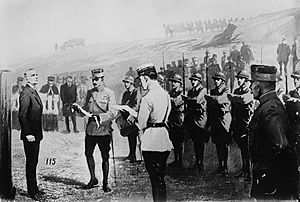Albert Leo Schlageter facts for kids
Quick facts for kids
Albert Leo Schlageter
|
|
|---|---|

Albert Leo Schlageter, 1918
|
|
| Born | August 12, 1894 Schönau im Schwarzwald, South Baden, German Empire |
| Died | May 26, 1923 (aged 28) Golzheim, Occupation of the Ruhr, Rhine Province, Weimar Republic |
| Allegiance | |
| Service/ |
|
| Rank | Leutnant |
| Battles/wars | World War I
Latvian War of Independence Kapp Putsch Silesian Uprisings |
Albert Leo Schlageter (12 August 1894 – 26 May 1923) was a German soldier who fought in World War I. After the war, he joined a group called the Freikorps, which were volunteer military units. He became known for trying to stop French forces who had occupied a part of Germany called the Ruhr area.
Schlageter was arrested for damaging a railway track. He was then executed by the French military. Because of how he died, many German nationalist groups, especially the Nazi Party, saw him as a hero who died for his country. During the time of Nazi Germany, he was widely remembered as a national hero.
Contents
His Life and Military Service
Schlageter was born in Schönau im Schwarzwald to a Catholic family.
Early Military Career
When World War I started, he volunteered to help the military. He fought in several important battles, like Ypres (1915), the Somme (1916), and Verdun. He earned two Iron Cross medals for his bravery. After becoming a leutnant (a military rank), he also took part in the Third Battle of Ypres in 1917.
After World War I
After the war, the German army was made much smaller. Schlageter left the army and briefly studied political science. Around this time, he joined a right-wing student group.
In March 1919, he joined the Baden Freikorps. He fought against a group called the Bolsheviks in the Latvian War of Independence. His unit helped capture Riga in Latvia. After his group was defeated in another battle, he returned to Germany.
Involvement in German Conflicts
In 1920, Schlageter took part in the Kapp Putsch, which was an attempt to overthrow the German government. He also fought in other battles between different military and political groups in Germany. His unit was involved in the Silesian Uprisings, fighting on the German side.
Around 1921, his unit joined with the growing Nazi Party. During the Third Silesian Uprising in 1921, Schlageter was involved in actions against people he and his group saw as enemies.
Sabotage and Execution
In 1923, French forces occupied the Ruhr region of Germany. Schlageter led a group of nationalists who tried to disrupt the French occupation. They did this by performing acts of sabotage, like derailing trains.
On April 7, 1923, the French learned about Schlageter's activities. He was arrested the next day. On May 7, 1923, a military court found him guilty and sentenced him to death. On the morning of May 26, he was executed by a firing squad near Düsseldorf.
On May 8, Schlageter wrote a letter to his parents. He said that since 1914, he had given all his effort to his German homeland out of love and loyalty. He wrote that he was not a criminal but tried to help his country.
A Heroic Symbol
After his execution, Albert Leo Schlageter became a hero to many people in Germany. A group called the Schlageter Memorial Society was formed to create a monument in his honor.
Nazi Commemoration
The Nazi Party especially used Schlageter's story to gain support. Adolf Hitler even mentioned him in his book, Mein Kampf. The Nazis created special ceremonies to remember his death. In 1931, a large monument was built near where he was executed. Smaller memorials were also created.
After 1933, when the Nazis came to power, Schlageter became one of their main heroes. Another hero was Horst Wessel, a Nazi stormtrooper who had been killed in 1930.
Many places were named after Schlageter. For example, in June 1933, Nazis dedicated a Schlageter Memorial on Dreisessel Mountain. The city of Passau also dedicated its own memorial and named a street and a plaza after him.
The Haus der Technik in Königsberg was renamed the Schlageterhaus. A Nazi writer named Hanns Johst wrote a play called Schlageter in 1933. It was dedicated to Hitler and showed Nazi ideas. A famous line from this play is, "Whenever I hear of culture... I release the safety-catch of my Browning!" This line is spoken by another character in the play.
Several important military groups and ships were also named after him. These included the Jagdgeschwader 26 Schlageter fighter-wing of the Luftwaffe (German air force) and the naval ship Albert Leo Schlageter. Two SA (Nazi stormtrooper) groups and an army barracks were also named in his honor.
After World War II
After World War II, the main Schlageter memorial was destroyed by the Allied forces. This was part of a process called denazification, which aimed to remove Nazi symbols and ideas. However, some smaller memorials remained for a while. The Schlageterinsel (Schlageter Island) near Soltau still carries his name today.
See also
 In Spanish: Albert Leo Schlageter para niños
In Spanish: Albert Leo Schlageter para niños


